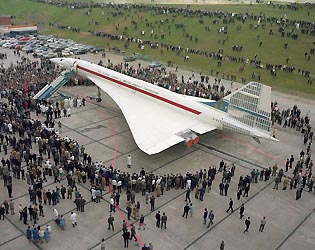The story of concorde
Concorde was an engineering marvel, and a style icon worldwide. Capable of crossing the Atlantic in under three hours, Concorde cruised at over twice the speed of sound and reached an altitude of 60,000ft. Her passengers would marvel at the curvature of the Earth, as they travelled at 1320mph and sipped Champagne on the edge of space.
Credit: BAE Systems
Concorde and Bristol
Bristol's connection to supersonic travel goes back to the late 1950s, when Bristol Aircraft at Filton started work on designing a supersonic airliner. Under the catch-all project code 'Type 198', several proposals were laid out, including an M-wing design and a six-engine high delta wing design.
Design
The Bristol design team was given the go ahead to develop a 110-seat long-range supersonic airliner, known as 'Type 223'. At the same time, Aerospatiale of France was developing their similar 'Super Caravelle'. To save costs, the development projects were combined, and the result was the Anglo-French Concorde.
Assembly
Components for Concorde were manufactured in several locations in the UK and France, and there were two assembly lines, one at Filton and one at Toulouse. The first British prototype made its first flight from Filton on 9th April 1969, 38 days after the French prototype. In all, ten were built at Filton and ten in France.
Power
Concorde was powered by four Rolls-Royce/SNECMA Olympus 593 engines. This engine is the direct descendant of the Bristol-Siddeley Olympus, the worlds first two-spool axial-flow turbojet engine, designed and built in Patchway. The Olympus 593 was flight tested from Filton Airfield fitted to the underside of a Vulcan bomber.
Support
Flight trials were performed from RAF Fairford, but the third British Concorde, 202, was based at Filton as a development aircraft when the Fairford test centre closed. It was grounded in 1980, but continued as a static test airframe until it was acquired by the Brooklands Museum in 2004.
Simulator
Filton was the home of the British Airways Concorde flight simulator, which entered service in 1975. This was mounted on six hydraulic rams to give the effect of flight. It originally used a model landscape and camera, but was upgraded to the latest computer technology in 1987.
The last Concorde
The final Concorde flight was made on 26th November 2003, when Concorde 216 flew from Heathrow to its final destination - Filton. En route, it made the last supersonic flight by an airliner for the foreseeable future. Here at Aerospace Bristol it is preserved for future generations, at the birthplace of supersonic travel.
Vital Statistics
Average cruise speed:
1,320mph (Mach 2.02)
Typical take-off speed:
250mph (220kt)
Max take-off weight:
185,070kg (408,000lb)
Cabin width:
2.63m (8ft 8in)
Height:
11.30m (37ft 1in)
Wing span:
25.56m (83ft 10in)
Length:
62.10m (203ft 9in)







